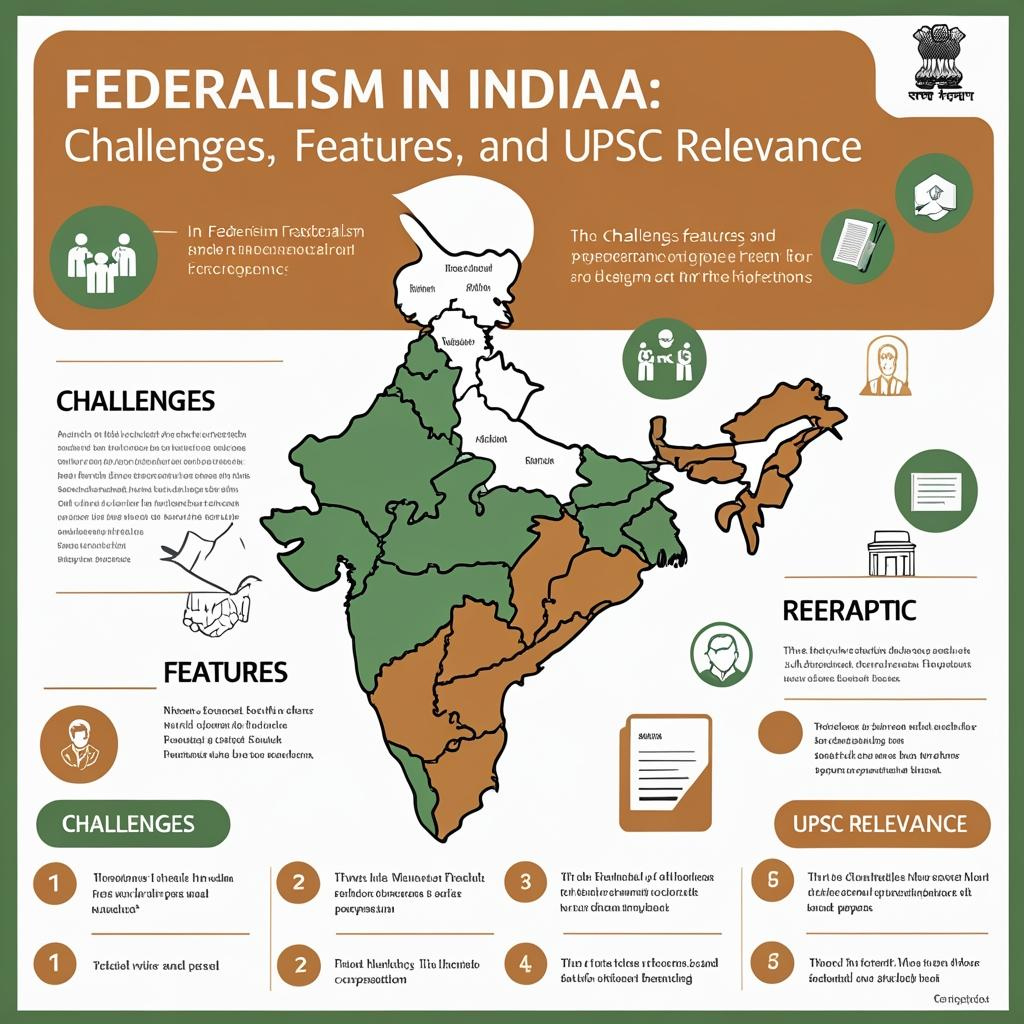1. Introduction
Federalism refers to a system of governance where power is divided between a central authority and constituent units (states/provinces), each operating within its own sphere of authority.
The Constitution of India, though not using the term “federal,” establishes a system with both federal and unitary features. Dr. B.R. Ambedkar famously called it “a federal system with a strong centralizing tendency”.
For UPSC, federalism is important in GS Paper II and Essay sections, with frequent Prelims questions on Centre–State relations, Schedules, Articles, and constitutional provisions.
Also Visit – Best IAS Coaching in India
2. Historical Background
- Government of India Act, 1935 introduced the concept of a federal structure for British India, though it never fully materialised.
- The framers of the Indian Constitution studied federal models like the USA, Canada, and Australia but adapted them to India’s unique socio-political context.
- Given India’s diverse population, regional aspirations, and history of partition, the framers opted for “cooperative federalism” with a strong centre to ensure unity.
3. Constitutional Provisions Related to Federalism
- Article 1: India is a “Union of States”.
- Seventh Schedule: Division of subjects into:
- Union List (97 subjects)
- State List (66 subjects)
- Concurrent List (47 subjects)
- Article 245–255: Distribution of legislative powers.
- Article 246: Parliament and State legislatures’ powers.
- Article 249–252: Parliament’s power to legislate on State List in specific cases.
- Articles 263: Interstate Council for coordination.
- Articles 356 & 360: Emergency provisions affecting federal balance.

4. Features of Indian Federalism
4.1 Written Constitution
Provides clarity on powers and responsibilities of the Union and states.
4.2 Supremacy of the Constitution
Both Union and states are bound by the Constitution; disputes are settled by the judiciary.
4.3 Division of Powers
Legislative subjects are clearly distributed via the Seventh Schedule.
4.4 Independent Judiciary
Supreme Court acts as the guardian of the Constitution and arbitrator in centre-state disputes.
4.5 Bicameral Legislature
Rajya Sabha represents the states at the Union level.
4.6 Strong Centre
The Union List’s dominance, residuary powers with Parliament (Article 248), and emergency provisions tilt the balance toward the centre.
5. Types of Federalism in India
- Cooperative Federalism: Centre and states collaborate in policymaking (e.g., GST Council, NITI Aayog).
- Competitive Federalism: States compete for investment, development, and better governance rankings.
- Fiscal Federalism: Financial relations between Union and states (Finance Commission, GST).
6. Judicial Interpretation of Federalism
- Kesavananda Bharati (1973): Federalism is part of the Basic Structure.
- S.R. Bommai (1994): Limited the misuse of Article 356; upheld federal principles.
- State of West Bengal v. Union of India (1963): States have no right to secede from the Union.
7. Challenges to Federalism in India
7.1 Centralisation of Power
- Residuary powers rest with the Union.
- Central government’s role in All-India Services and planning.
7.2 Misuse of Article 356
- In the past, frequent dismissal of state governments on political grounds.
7.3 Fiscal Imbalance
- States depend heavily on Union transfers; GST has increased central control over taxation.
7.4 Interstate Disputes
- Water disputes (e.g., Cauvery, Krishna, Ravi-Beas).
- Boundary disputes (e.g., Assam–Mizoram).
7.5 Role of Governors
- Allegations of partisan behaviour in inviting parties to form government or withholding assent to bills.
7.6 Regionalism and Secessionist Movements
- Ethnic, linguistic, and cultural demands sometimes challenge national unity.
8. Measures to Strengthen Federalism
- Strengthening Inter-State Councils under Article 263.
- Revisiting the Role of Governors with clear guidelines.
- Fiscal Decentralisation with more untied grants to states.
- Empowering State List Subjects in practice, not just in theory.
- Timely Resolution of Interstate Disputes through tribunals.
- Strengthening Cooperative Mechanisms like GST Council, Zonal Councils.

9. Role of Finance Commission in Federalism
- Constituted every 5 years under Article 280.
- Recommends distribution of tax revenue between Centre and states (vertical devolution) and among states (horizontal devolution).
- The 15th Finance Commission recommended 41% share of central taxes to states (2021–26 period).
10. Federalism and Recent Developments
- Abolition of Article 370 in Jammu & Kashmir (2019): Reduced its special status; created new UTs.
- GST Implementation (2017): Example of cooperative federalism but also increased central role in taxation.
- COVID-19 Pandemic: Centre invoked Disaster Management Act; debates over federal jurisdiction in health matters.
- Farm Laws Controversy (2020–21): Led to protests over encroachment on state powers related to agriculture.
11. UPSC Relevance
Prelims Focus:
- Articles 1, 246, 249–252, 280, 356.
- Schedules related to distribution of powers.
- Finance Commission roles.
Mains Angle:
- GS Paper II: “Indian federalism is a unique blend of unitary bias and federal spirit—discuss.”
- Essay Topics: “Federalism as a tool for managing diversity in India.”
12. Conclusion
Indian federalism is dynamic and adaptive, shaped by historical experiences and current realities. While the Constitution envisages a strong Centre, the spirit of cooperative federalism has helped manage diversity and complexity in governance. Strengthening fiscal autonomy, ensuring transparent Centre–State relations, and fostering genuine cooperation are key to making federalism a pillar of democratic stability in India.
For Answer Writing Techniques – Join FIRST IAS INSTITUTE

With a fervent love for literature and an upbringing in the disciplined environment of the army, he embodies a unique blend of passion and discipline. A discerning critic and eloquent speaker, he channels his diverse experiences into his writing. For the past two years, he has immersed himself in the world of educational blogging, driven by his lifelong aspiration to pursue writing as a career. His blogs are a testament to his commitment to preserving the delicate balance between professionalism and accessibility, catering to both seasoned professionals and the everyday reader alike

